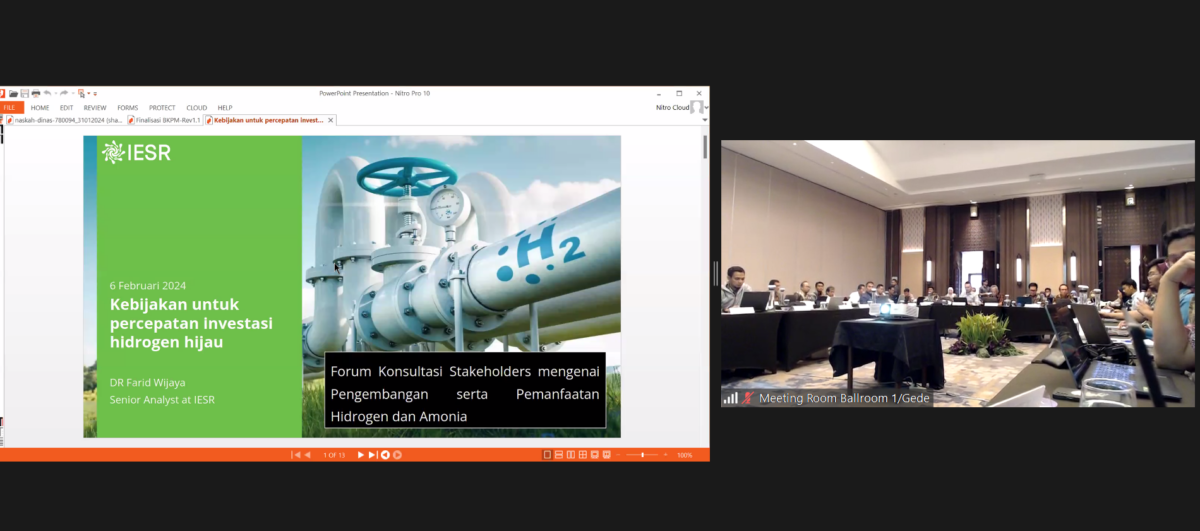Bogor, February 6, 2024 – In facing the increasingly urgent challenge of climate change, one of the crucial steps that must be taken is to accelerate investment in clean energy technologies. One of the most prominent recent innovations is the development of green hydrogen. Based on data from the Ministry of Energy and Mineral Resources (MEMR), Indonesia has a renewable energy potential of around 3,686 gigawatts, which makes it possible for the country to produce green hydrogen.
Farid Wijaya, Senior Analyst at the Institute for Essential Services Reform (IESR), explained that, unlike fossil fuels, hydrogen energy generates only water, electricity, and heat when converted, it does not leave any trace of greenhouse gas emissions or fine dust. The production process is also environmentally friendly, particularly when using the electrolysis method to separate hydrogen from water compounds, where an electric current is used to break down water molecules into oxygen and hydrogen gas. This makes green hydrogen a way to respond to the need for environmental balance and offers opportunities to create new markets and value for industries around the world.
“According to the IESR study conducted with the Ministry of Investment / Investment Coordinating Board (BKPM), green hydrogen has several significant benefits. These include reinforcing national energy security, accelerating decarbonization, promoting a sustainable economy, storing excess electricity, and enabling fair access to renewable energy. It is an efficient alternative to fossil fuels that can be converted into NH3, alcohol (such as methanol and ethanol), methane, and synthetic fuels. Additionally, its energy density is higher than batteries while being equally practical to fuel oil (bahan bakar minyak, red)” Farid said in the Stakeholders Consultation Forum on the Development and Utilization of Hydrogen and Ammonia on Tuesday (6/2/2024).
Furthermore, Farid highlighted several factors that support the commercialization of green hydrogen. First, the advantages, benefits, and obligations in use. Second, the availability and accessibility of technology, time, and safety. Third, affordable and competitive prices are accompanied by investment and operations. Fourth, user, environment, and community friendliness.
“Reflecting on this, we need cooperation and innovation from both the private sector and government, when it comes to meeting the demand for green hydrogen. This involves transformation and transition of economic values to environmentally friendly and green, high market demand to encourage investment, as well as a direction map and regulatory policies to support national transformation and transition,” Farid said.
Indonesia, said Farid, can learn from other countries that have implemented green hydrogen. For instance, Fortescue Australia faced challenges in funding 550 MW electrolyzer capacity on Gibson Island due to high investment and electricity costs for utilizing hydrogen as an ingredient of ammonia. Some of the issues encountered include high investment and operational costs, limited government subsidies, and the high price of ammonia as a fertilizer.
“To minimize the occurrence of unwanted events in the use of green hydrogen, we need to take strategic steps. First, standardization and certification, which is important to maintain the value of a safe and controlled supply chain. Second, the establishment of policy direction maps and regulations that support the development of green hydrogen in Indonesia. Third, access to resources, especially related to defense, determines the cost efficiency of investment, energy, and mobility. Fourth, the availability of hydrogen utilization technology, in building a domestic market for sustainable utilization. Fifth, potential markets, especially for global export markets, have high selling points and domestic markets. Sixth, financial support such as the provision of binding incentives and disincentives,” Farid explained.

